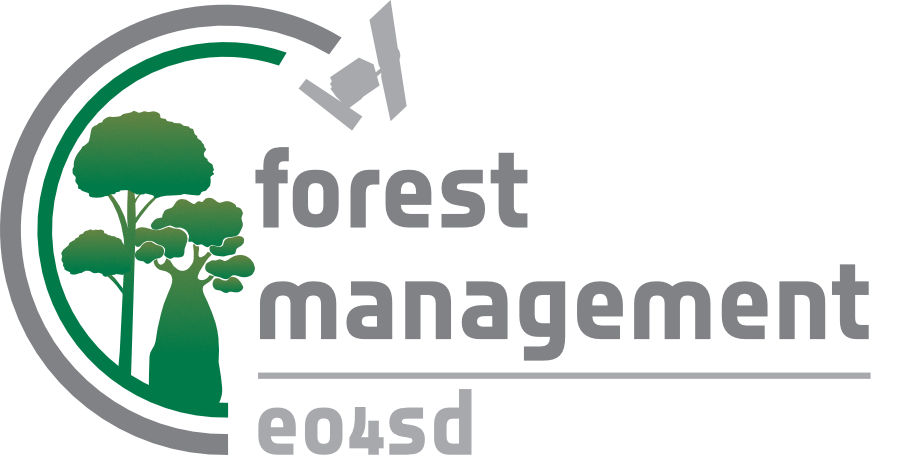EO4SD-FOREST MANAGEMENT
an ESA project aimed at deriving key geo-information products from Earth Observation
data in support of forest development programmes
Forests are an important habitat with multiple functions and play a major role as global carbon sinks. While forests offer a potential solution to ongoing challenges in climate change mitigation, their sustainability is increasingly under threat. Pressure towards expanding agricultural land leads to illegal deforestation, habitat and biodiversity loss, and deprives forest-dependent communities of their livelihoods.
Several International Conventions and policy frameworks aim to protect and improve the management of forests. These include the United Nations Convention on Climate Change (UNFCCC) policy process related to reducing emissions from deforestation and degradation (REDD+), the UN Convention on Biological Diversity (UNCBD) and the UN Sustainable Development Goals (SDG) 13 and 15, and the EU Forest Law Enforcement, Governance and Trade (FLEGT) programme.
Accurate information and monitoring systems to support countries to make assessments and track changes are required but is challenging. By nature, forests cover huge and often inaccessible and inhospitable areas, making observation of their status and condition with human teams challenging.
Monitoring forests is crucial and Earth Observation (EO) is the only cost-effective solution, providing global, comprehensive, accurate, repeatable and timely, and is invaluable in the planning and implementation of Forestry Management activities.
Earth Observation for Sustainable Development (EO4SD) is an ESA initiative which aims to support International Finance Institutions and their Client States to harness the benefits of EO in their development operations at national and international level. EO4SD-Forest management was initiated in 2020 and will run until 2024.
All Webinars available online
The EO4SD-Forest Monitoring (EO4SD-FM) consortium hosted a series of webinars during the year 2023. All webinars were recorded and can be accessed online at www.youtube.com/@EO4SD-Forest.
Some introductory material on using Earth Observation (EO) for Forest Monitoring (FM) can be found in the section ‘Training Material’.
How can Earth Observation (EO) improve Forest Management?
Watch this short video to get an overview of the various ways in which EO can support and enhance forest management around the world.
Objectives
The ESA EO4SD Forest Management Cluster project – aimed to demonstrate the utility and benefit of mainstreaming EO-based forest related products and services for improved Forest Monitoring and Management for IFI programmes and stakeholders in Client States (CS). More specifically the project provided a quality assured portfolio of geo-spatial products that were used in specific countries in Latin America, South East Asia and Africa. To this end the products and services were user-driven requiring strong stakeholder engagement from project inception to end; stakeholders were requested especially to validate the products in terms of overall utility for integration into work practices. Finally an important aspect of the project was to provide technology transfer to the IFIs and CS via capacity building exercises in the different regions.
Earth Observation (EO) and Forest Management
Tropical forests are an important habitat with multiple functions playing a major role as global carbon sinks which offer solutions to the on-going challenges in climate change mitigation. Several international Conventions and policy frameworks such as the United Nations Convention on Climate Change (UNFCCC) policy process related to reducing emissions from deforestation and degradation (REDD+), the UN Convention on Biological Diversity (UNCBD) and the UN Sustainable Development Goals (SDG) 13 and 15, and the EU Forest Law Enforcement, Governance and Trade (FLEGT) programme aim to protect and improve the management of forests. In line with these policy frameworks, the amount of financial support to developing countries from development co-operation or Official Development Assistance (ODA) has also been increasing from 2000 onwards.
Due to various technological and resources challenges in developing countries the operationalisation of EO data for forest monitoring still lags behind. In this context the International Finance Institutes (IFIs) who fund the ODA programmes in developing countries have a strong role in facilitating the mainstreaming of the technology in their work practices. Globally important forest management themes where EO can support the assessment of forest area, forest damage and forest area change include: REDD+ process especially for the Dry Tropical Forest Ecosystems, the assessment of drivers of Deforestation and Forest Degradation, supporting Community Based REDD+ , Mangrove Protection and Forest Landscape Restoration.
Where we worked
The EO4SD-Forest Management project was collaborating with International Financial Institutions (IFI), such as the World Bank (WB) and the Asian Development Bank (ADB) to demonstrate programme tailored EO-based information to support their Forestry Management decision making.
The regions in which the project was carried out includes Latin America, South East Asia and Africa. The country programmes were selected in partnership with IFIs.
Project Consortium
The consortium was led by GAF AG (Germany) and a Consortium of European and Canadian expert partners (Caribou Space/UK, Hatfield/Canada, Indufor/Finland, CLS/France, Wageningen University/Netherlands) who have well established experience in the provision of geo-spatial data and services for forest monitoring and management especially in the UNFCCC REDD+ policy segment.







